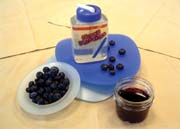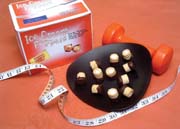
The secret formula is well stated in the opening page of The South Beach Diet: ...rely on the right carbs and the right fats...
Facts are facts, though, and the data cannot be denied. Last year, according to retail sales figures from Information Resources Inc., bread sales were down 1.1% while "low-carb" products totaled more than $1.2 billion in sales. The concept of low carb sells.
Indeed, there's no question that right now the low-carb food and beverage business translates to big bucks for those formulators that have the magic touch to deliver on both fewer carbohydrates and great flavor. I do predict, however, that formulating foods and beverages with longevity requires much more than simply lowering carbs. And dairy foods, as well as dairy ingredients play a significant role in these innovations.
Michael Sansolo, FMI's senior v.p., said during the opening FMI session that the current distaste for carbohydrates might be supplanted in a couple of years by avoidance of trans fats. There is much validity to this statement. After all, it won't be long before trans fat contents show up on Nutrition Facts labels, very near the carbohydrate line. Consumers will notice.

Now, I don't think the low-carb thing will go away, but I do believe it will be repositioned, as consumers simply don't need the amount of carbohydrates they have been consuming during the past 10-plus years. Many must agree with me, as it is not I carrying those soft drink vending machines out of schools across the country.
Minneapolis-based General Mills Inc., understands that there are a growing number of con-sumers who want to reduce the amount of simple sugars in their diet. At FMI, the company rolled out its version of a low-carb yogurt (see page 26). Unlike similar products in the marketplace, General Mills does not have "carb" in the brand name. Called Yoplait® Ultra™, product labels contain such descriptive phrases as "Reduced-sugar low-fat yogurt" and "For your low-carb lifestyle."
Michelle Carr, associate marketing mgr., comments on the product. "We believe there are so many great things about this product. Not only does it have 70% less sugar and 70% less carbohydrates than regular low-fat yogurt, it also is an excellent source of calcium and a good source of protein, which is how we came up with the name Ultra," Carr says. The Yoplait Ultra formula includes whey protein concentrate. Each 6-oz cup contains 8g protein and 8g carbohydrates, five of which classify as "effective" or "net carbs."
Choosing such better-for-you foods is indeed the movement.
The USDA campaign that Bost is leading addresses the obesity crisis in the United States. Bost is actively collecting consumers' concerns and complaints in a series of public forums across the nation. The key here is that USDA's emphasis is not on losing weight but on moving toward a healthier lifestyle by making better food choices (dairy foods fit in perfectly here), controlling portions and exercising.
In addition to the general healthful halo surrounding dairy foods, there is increasing scientific evidence that weight management is not just about carbohydrates or fat, or for that matter, even just calories. It's a variety of factors, and dairy foods, particularly dairy proteins, play a major role.
This month's Tools for Innovation supplement, which is a joint editorial effort between Dairy Foods and Dairy Management Inc. (DMI), Rosemont, Ill., looks at how dairy proteins can be used to formulate those "better food choices." DMI, and dairy-affiliated associations around the country are actively pursuing applications for dairy proteins, and are an excellent resource to tap into for innovative dairy foods ideas. Here's a sampling of some efforts:
Researchers at the Dairy Research Center at South Dakota State University are developing a new calcium-rich dairy creamer from whey. They have identified a process that transforms whey mineral concentrate into a smooth, creamy product.
"In our preliminary research, we observed a gritty mouthfeel when we incorporated whey mineral concentrate into coffee, tea and other neutral pH beverages," says Researcher Rajiv Dave. "However, when used with acidic beverages, such as juice, it dissolves completely.

University of California-Davis researcher John Krochta has been active with efforts to commercialize his work on whey protein films and coatings for food safety. Whey protein films and coatings can carry bioactive compounds that provide antimicrobial and antioxidant protection for foods. Bioactive compounds can offer significant added value by increasing the safety, shelflife and quality of food, therapeutic and nutritional products.
"This project will launch significant commercial opportunities not only for food preservation projects, but also for subsequent therapeutic and nutritional products using the same platform," says Krochta, a professor of food science and technology at UC Davis.
Finally, in its sixth year, DMI's Discoveries in Dairy Ingredients Contest yielded some truly amazing innovations. Student teams, whom the contest is open to, created product prototypes for snacks, desserts, candy, beverages and more, highlighting the versatility of dry and condensed milk ingredients, fluid milk, whey and whey derivatives, milkfat and cheese ingredients.
"The contest entries this year really promote both the functional and nutritional properties dairy ingredients can offer to any food category," says Laura Gottschalk, dir., ingredient channel development, DMI. "The concepts were unique, yet practical enough to appear one day in retail and foodservice."
A team from the University of Minnesota in St. Paul was voted "Best Overall" for its entry of "Ice Cream Poppers," a premium, reduced-carbohydrate, bite-sized frozen novelty. The concept combines whey protein concentrate, milk, cream and vanilla into a creamy frozen core, surrounded by a crunchy, reduced-carbohydrate base made from almond flour, wheat bran, whey protein, wheat starch and sugar. The individual pieces are coated with chocolate, adding indulgence to the high-protein, high-fiber treat.
Judges awarded the "Most Creative" distinction to "Berry Blasters" from Cornell University, Ithaca, N.Y. The student team developed a color-changing dairy and fruit juice beverage for kids using microfiltrate whey. The package base contains white cranberry juice and microfiltrate whey, while the cap features soft color-changing gummy balls. Kids can mix the two together and sip the drink through a straw.
Winning entries will be featured at the DMI exhibit at IFT. Come see how dairy ingredients, particularly dairy proteins, can help your company innovate and provide consumers with better-for-you food choices.

